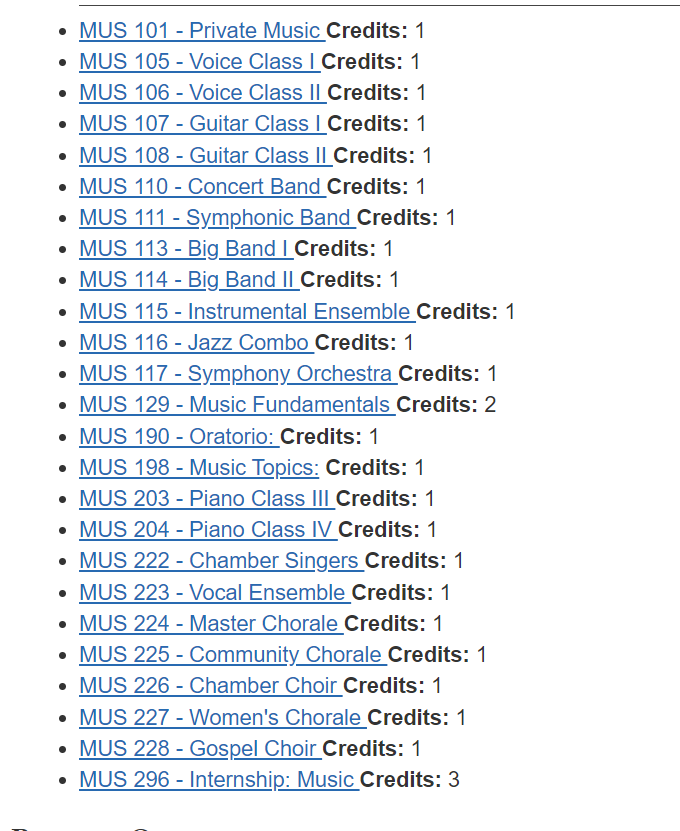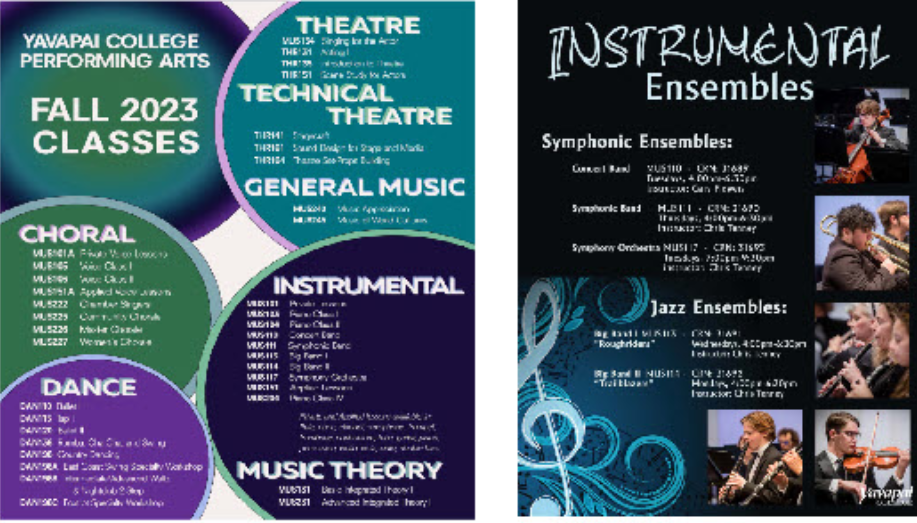Associate of Arts in Fine Arts degree with a concentration in Music is offered but virtually all classes taught in Prescott – Chorales, bands, Symphony Orchestra, jazz ensembles, individual instruction and more not offered in Sedona/Verde Valley with exception of two voice classes
 OPINION: For over 50 years, Yavapai Community College leadership has focused its efforts on building an extensive music program exclusively on the Prescott Campus. Throughout this time, it has neglected to make similarly accessible music instruction reasonably available to students in other parts of Yavapai County. With the approval of the District Governing Board, this concentrated effort has resulted in a full range of music courses being offered solely in Prescott—such as music theory, piano classes, music appreciation, private lessons, and performance ensembles. This focus has also produced impressive student music groups, including the Master Chorale, Community Chorale, Women’s Chorale, Chamber Singers, Concert Band, Symphonic Band, Symphony Orchestra, and Jazz ensembles, providing students with opportunities to develop their musical talents collaboratively. Additionally, the Community College now offers an Associate of Arts in Fine Arts degree with a concentration in Music—yet music instruction in person is provided only on the Prescott Campus.
OPINION: For over 50 years, Yavapai Community College leadership has focused its efforts on building an extensive music program exclusively on the Prescott Campus. Throughout this time, it has neglected to make similarly accessible music instruction reasonably available to students in other parts of Yavapai County. With the approval of the District Governing Board, this concentrated effort has resulted in a full range of music courses being offered solely in Prescott—such as music theory, piano classes, music appreciation, private lessons, and performance ensembles. This focus has also produced impressive student music groups, including the Master Chorale, Community Chorale, Women’s Chorale, Chamber Singers, Concert Band, Symphonic Band, Symphony Orchestra, and Jazz ensembles, providing students with opportunities to develop their musical talents collaboratively. Additionally, the Community College now offers an Associate of Arts in Fine Arts degree with a concentration in Music—yet music instruction in person is provided only on the Prescott Campus.
The lack of reasonable opportunities for music education outside the Prescott Campus can be traced to several key failures: the logistical barriers posed by the county’s vast geography, the absence of public or college-provided transportation, frequently hazardous travel conditions between the county’s east and west sides, and a glaring disregard for the realities of Community College student life beyond Prescott. These factors collectively demonstrate a profound disconnect between college leadership and the needs of students outside Prescott.
 The Expansive Reach of Yavapai County
The Expansive Reach of Yavapai County
It seems Yavapai College’s leadership is oblivious to the fact that its district spans all 8,125 square miles of Yavapai County—an area larger than several entire U.S. states. For context, this landmass exceeds Connecticut (5,543 square miles, with 12 colleges and universities), Delaware (1,982 square miles, with three), Rhode Island (1,214 square miles, with three), and nearly matches New Jersey (8,723 square miles, with 19). Even Israel, slightly larger at 8,550 square miles, supports ten universities and 53 colleges. Yet, despite this vast expanse, Yavapai College leadership and its Governing Board have concentrated the music program solely on the Prescott Campus, apparently because of its higher population density. This failure to consider the realities of the county’s geographic scale and the resulting accessibility issues for students outside Prescott is baffling. This centralized approach effectively excludes students from Sedona and the Verde Valley, denying them meaningful access to music instruction.
Geographic Barriers and Accessibility Challenges
 Barriers to Student Success
Barriers to Student Success
Another major barrier to student access to music classes is the District Governing Board’s failure to account for the real-life circumstances of students across Yavapai County. Although the Board frequently claims its mission is to serve students and support their success, the lack of accessible music education for students in Sedona and the Verde Valley tells a different story. Many students juggle part- or full-time jobs and family obligations, making lengthy commutes to Prescott impossible. For some, transportation is an added hurdle, with no inter-campus transit options provided by the Community College. Rising fuel costs further compound the financial strain.
Moreover, Yavapai Community College has acknowledged that nearly 20% of its student body faces partial or complete homelessness, exacerbating these challenges. For these students, the lack of resources and stability makes regular travel to Prescott unfeasible, underscoring the inequity in the College’s centralized approach to its music program and its failure to recognize the diverse realities of its entire student body.
Conclusion:
Yavapai Community College’s centralized music program on the Prescott Campus starkly contrasts with its stated mission to serve all students and foster their success. By investing resources solely in Prescott, the College sends a message that educational opportunities in music—and perhaps other programs—are only for those who can access the West side of Yavapai County. This approach disregards the unique needs and challenges of students from Sedona and the Verde Valley, who must contend with long, costly, and sometimes dangerous commutes if they wish to participate.
Moreover, by neglecting these regions, Yavapai College risks leaving behind talented students who could enrich its music programs. Those in Sedona and the Verde Valley deserve a reasonably equal opportunity to pursue music education within their own communities.
It’s time for Yavapai College to live up to its responsibilities as a district-wide institution, investing in infrastructure and program accessibility across the county. Without meaningful steps toward inclusivity, the Community College’s promises to support every student’s success will remain unfulfilled, and the Sedona and Verde Valley communities will continue to shoulder the burden of being underserved. Only by broadening its approach to education can Yavapai Community College truly claim to represent and support all students within its reach.
